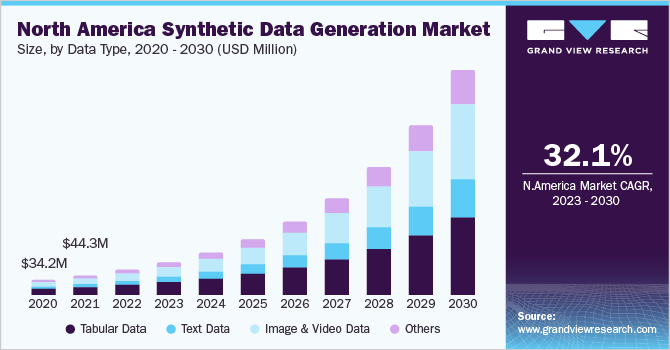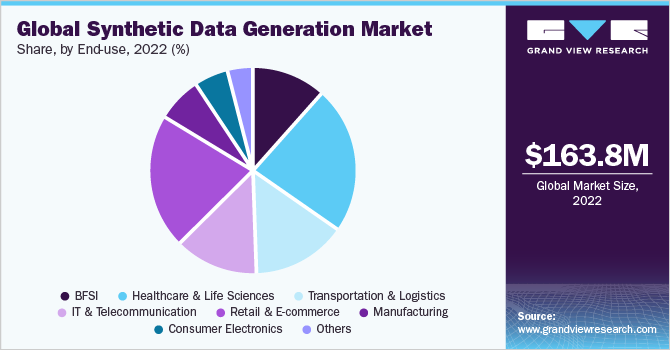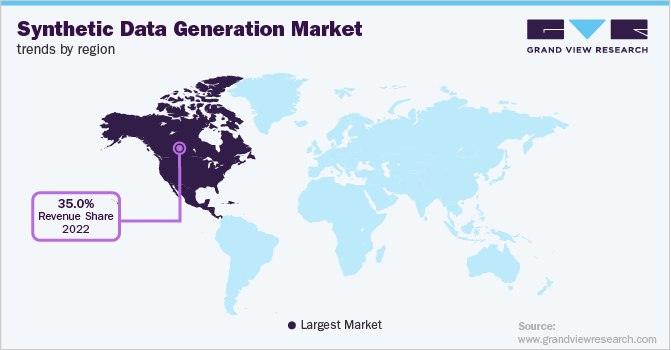
Synthetic Data Generation Market Size, Share & Trends Analysis Report By Data Type, By Modeling Type, By Offering, By Application, By End-use, By Region, And Segment Forecasts, 2023 - 2030
- Report ID: GVR-4-68039-982-5
- Number of Pages: 100
- Format: Electronic (PDF)
- Historical Range: 2017 - 2021
- Industry:Technology
Report Overview
The global synthetic data generation market size garnered USD 163.8 million in 2022 and is expected to witness a CAGR of 35.0% from 2023 to 2030. An uptick in the synthetic generation of data following the rising penetration ofArtificial Intelligence(AI) has spurred the industry’s growth. For Instance, in August 2020, the White House reportedly announced an infusion of USD 1 billion in AI and quantum computing. Demand for data has become pronounced with a growing footfall of connected devices andIoT, further expediting the need for synthetic data to generate on-demand data. Industry players are expected to seek synthetic data to address the gap in data provision.

Synthetic data is also popular as fake data that can be used in place of real data to train AI models. Industry players have exhibited an increased demand for simulated data in the wake of a surging penetration of the privacy-preservation solution. Moreover, an exponential rise in machine learning has shifted the attention towards synthetic data. Artificial data leverages AI and machine learning technology by accessing massive data sets.
The urgency to adhere to the privacy laws, including GDPR, will augur well for major companies gearing to foster their portfolios. Some other expanding applications of the created data include training models amidst a shortage of real data and ramp-up model developments, among others. Prominently, artificial data can help train and foster models before the availability of real data and minimize costs.
AI stakeholders have exhibited increased synthetic data traction across emerging and advanced economies. For instance, in September 2021, a study from Synthesis AI in collaboration with Vanson Bourne suggested that 89% of technology decision-makers see synthetic data as a key to staying ahead. Tech executives will likely bank on artificial data to enhance data quality and bolster productivity. In the nascent stage, synthetic data generation is expected across industry verticals, including automotive and healthcare, to improve access, contain cost, and minimize the time taken to build AI models.
Data Type Insights
In terms of revenue, the tabular data segment held the largest share of over 38% in 2022. Stakeholders expect the tabular data segment to account for a significant share of the global market, mainly due to bullish demand from researchers. In October 2020, MIT researchers introduced a set of open-source data generation tools-Synthetic Data Vault.
The researchers asserted that users would get data for their projects in tables and time series formats. Moreover, in 2019, a team of researchers proposed conditional tabular GAN (CTGAN) to boost the training procedure with mode-specific normalization and address data imbalance, among others. With researchers emphasizing tabular data, end-user sectors will likely bank on artificial data for data privacy protection.
图像和视频数据段预计将contribute significantly toward synthetic data generation market share on the back of soaring demand to boost the database. Furthermore, the use of synthetic media as a drop-in replacement for the original data has become noticeable across developing and developed countries. Prominently, synthetic images & videos have amassed massive popularity across the automotive sector.
For instance, in July 2019, Waymo claimed to have driven more than 10 billion miles in simulation. Industry players are anticipated to use synthetic images & video data to train systems that spot fire trucks, police cars, ambulances, and other emergency vehicles, boding well for the industry growth.
Modeling Type Insights
In terms of revenue, the agent-based modeling segment accounted for the highest share of 60% in 2022. Agent-based modeling (ABM) has garnered popularity for creating a physical model of real-world data and reproducing data using the same model. Lately, agent-based modeling has gained ground over traditional models in the financial sector.
It has become highly sought after in generating business transactions for testing and developing fraud detection systems. Industry participants are expected to count on ABMs to leverage the modeling of various sorts of networks. ABMs have also gained prominence in simulating consumer interactions, innovations, and autos and roadways.
Market players have prioritized ABMs due to their robust traffic control and management penetration. For instance, agent-based modeling has become trendier to emphasize car sharing or route choice and generate novel systems and strategies. Moreover, psychological characteristics have gained ground to foster the agent models. Agent-based simulation has also received impetus in sharing mobility research for information-transferring processes and returning effective feedback.
Offering Insights
The fully synthetic data segment led the synthetic data generation market with the largest revenue share of 35% in 2022. The hybrid synthetic data segment is poised to witness a notable CAGR during the forecast period. The upward growth trajectory is mainly attributed to privacy preservation with increased utility as it offers upsides of complete and partially synthetic data. While the trend for hybrid synthetic data will be noticeable across end-use sectors, the possible need for longer processing time may challenge the market growth.
涉众预测完全合成哒ta segment contributing significantly to the global market value. The upward growth trajectory is partly due to the need for increased privacy across emerging and advanced economies. Prominently, leading companies have augmented investments in fully synthetic to boost their penetration in the automotive industry.
For instance, in May 2022, Waymo was reported to have announced building the World’s Most Experienced Driver. The company claims it can generate fully synthetic data on a real-world scale, ramp up data generation rates, and enhance iteration speeds.
Application Insights
The natural language processing segment held a leading revenue share of over 26% in 2022. Synthetic data has witnessed an exponential use in natural language processing as it helps bootstrap new language releases. In October 2019, Amazon announced versions of Alexa in the U.S. Spanish, Hindi, and Brazilian Portuguese.
The company has increased its focus on synthetic data to streamline and complete the training data of its natural-language-understanding (NLU) systems. Recent advanced in NLP will further expedite the need for synthetic data to leverage enterprises to move faster.
Predictive analytics has also emerged as a promising application segment, driven by solid demand from the BFSI sector. Banks and financial sectors are likely to use synthetic data in predictive analytics for fraud detection. For instance, in September 2020, American Express reported testing technology to help create fake videos to combat financial fraud.
The company uses generative adversarial networks to identify credit card scams to generate fictitious financial data that look like credit card transactions. Moreover, the insurance sector has exhibited traction for predictive analytics to augment sales and minimize underwriting expenses. End-users are likely to use artificial data for predictive analytics to find the needs and demands of customers and boost their satisfaction.
End-use Insights
In terms of revenue, the healthcare & life sciences segment accounted for the highest share of 22% in 2022. The healthcare & life science sector is poised to show bullish demand for privacy-protecting synthetic data. Amidst challenges from data breach risks, patient privacy, regulatory frameworks, separate data sources, and artificial data generation tools have gained significant momentum.
For Instance, in May 2022, Anthem Inc. announced joining Alphabet Inc.’s Google Cloud to create 1.5 to 2 petabytes of synthetic data for better fraud detection and personalized services. The strong potential of synthetic data in healthcare for increased agility and privacy regulations will continue to foster the position of leading companies in the global market.

Artificial data has provided a fillip to the retail and e-commerce sector to train AI models and expedite data sharing within the organization and outside the enterprise. Brands and retailers use synthetic data to streamline data exchange with vendors and propel advertising and promotions.
Moreover, retailers are also cashing in on tech companies using synthetic business data for analytics and training. Lately, using artificial data has also gained ground for efficient inventory and warehousing management. With a surge in online purchases, the e-commerce players could further propel investment in synthetic data generation software.
Regional Insights
In terms of revenue, North America held the leading share of 35% in 2022. The U.S. and Canada have emerged as lucrative regions as end-use sectors have shown an increased inclination toward fraud detection, NLP, and image data. Several companies, including J.P. Morgan, American Express, Amazon, and Google’s Waymo, have upped investments in synthetic data.
For instance, in June 2022, Amazon introduced Amazon SageMaker Ground Truth to generate labeled synthetic image data. These industry players will show an inclination toward synthetic data to train machine learning, payment data for fraud detection, and anti-money laundering behaviors.

Furthermore, the expanding footprint of computer vision will also fare well in the North America synthetic data generation market forecast. Manufacturing, geospatial imagery, and physical security have garnered pronounced traction. For instance, in March 2022, Datagen, with offices in New York and Tel Aviv, raised USD 50 million in Series B to foster synthetic data solution growth for computer vision teams.
Besides, the growing prominence of autonomous vehicles has provided an impetus to simulation data across the region. Autonomous vehicles have gained ground with simulation data, enabling companies to test edge cases, and keeping the risk of accidents at bay. Advanced economies, such as the U.S., have reinforced the autonomous simulation platform for rigorous training demands and the development of self-driving vehicles.
Key Companies & Market Share Insights
The competitive scenario refers to developing and developed countries emphasizing organic and inorganic growth strategies. Leading companies will likely provide synthetic data products and services to overcome security concerns, governance processes, and legacy infrastructure issues. Further, the rising prominence of data sharing, computer vision algorithms, NLP, and predictive analytics will redefine the global landscape.
在新兴的合成数据空间,发展农业tunities could be galore in the ensuing period. Infusion of funds into mergers & acquisitions, product launches, innovations, and R&D activities could be noticeable. To illustrate, in April 2022, Synthesis AI raised USD 17 million in Series A to generate synthetic data for computer vision AI, bringing the total funding to more than USD 24 million.
The company contemplates bolstering research with an emphasis on mixed training (synthetic and real), neural rendering, and complex human behavior modeling. Besides, in October 2021, Facebook acquired AI. Reverie, suggesting large and small companies have upped the adoption of synthetic data to propel AI strategies. Some prominent players in the global synthetic data generationmarket include:
Mostly AI
Synthesis AI
Statice
YData
Ekobit d.o.o.
Hazy
Kinetic Vision, Inc.
Kymera-labs
MDClone
Neuromation
TwentyBN
DataGen Technologies
Informatica Test Data Management
Synthetic Data Generation Market Report Scope
Report Attribute |
Details |
Market size value in 2023 |
USD 218.35 million |
Revenue forecast in 2030 |
USD 1.79 billion |
Growth rate |
CAGR of 35% from 2023 to 2030 |
Base year for estimation |
2022 |
Historical data |
2017 - 2021 |
Forecast period |
2023 - 2030 |
Quantitative units |
Revenue in USD million/billion and CAGR from 2023 to 2030 |
Report coverage |
Revenue forecast, competitive landscape, growth factors, and trends |
Segments Covered |
Data type, modeling type, offering, application, end-use, region |
Regional scope |
North America; Europe; Asia Pacific; South America; MEA |
Country scope |
U.S.; Canada; Mexico; U.K.; Germany; France; China; Japan; India; Brazil |
Key companies profiled |
Mostly AI; Synthesis AI; Statice; YData; Ekobit d.o.o.; Hazy; Kinetic Vision, Inc.; Kymera-labs; MDClone; Neuromation; TwentyBN; DataGen Technologies; Informatica Test Data Management |
Customization scope |
Free report customization (equivalent up to 8 analyst working days) with purchase. Addition or alteration to country, regional, and segment scope. |
Pricing and purchase options |
Avail customized purchase options to meet your exact research needs.Explore purchase options |
Global Synthetic Data Generation Market Segmentation
This report forecasts revenue growth at the global, regional, and country levels and provides an analysis of the latest industry trends in each of the sub-segments from 2017 to 2030. For this study, Grand View Research has segmented the global synthetic data generation market report based on data type, modeling type, offering, application, end-use, and region:
Data Type Outlook (Revenue, USD Million, 2017 - 2030)
Tabular Data
Text Data
Image & Video Data
Others (Audio, Time Series, etc.)
Modeling Type Outlook (Revenue, USD Million, 2017 - 2030)
Direct Modeling
Agent-based Modeling
Offering Outlook (Revenue, USD Million, 2017 - 2030)
Fully Synthetic Data
Partially Synthetic Data
Hybrid Synthetic Data
Application Outlook (Revenue, USD Million, 2017 - 2030)
Data Protection
Data Sharing
Predictive Analytics
Natural Language Processing
Computer Vision Algorithms
Others
End-use Outlook (Revenue, USD Million, 2017 - 2030)
BFSI
Healthcare & Life Sciences
Transportation & Logistics
IT & Telecommunication
Retail and E-commerce
Manufacturing
Consumer Electronics
Others
Regional Outlook (Revenue, USD Million, 2017 - 2030)
North America
U.S.
Canada
Mexico
Europe
U.K.
Germany
France
Asia Pacific
China
Japan
India
南美
Brazil
MEA
Frequently Asked Questions About This Report
b.The global synthetic data generation market size was estimated at USD 163.8 million in 2022 and is expected to reach USD 218.35 million in 2023
b.The global synthetic data generation market is expected to grow at a compound annual growth rate of 35% from 2023 to 2030 to reach USD 1.79 billion by 2030.
b.North America dominated the synthetic data generation market with a share of 35% in 2022. This is attributable to rising penetration of Artificial Intelligence (AI) coupled with a growing footfall of connected devices and IoT and constant research and development initiatives.
b.Some key players operating in the synthetic data generation market include Mostly AI, Synthesis AI, Statice, YData, Ekobit d.o.o, Kinetic Vision, Inc., Kymera-labs, MDClone, Neuromation, TwentyBN, DataGen Technologies, Informatica Test Data Management, etc.
b.Key factors that are driving the market growth include increasing demand for data security and privacy, rising investment in advanced technologies, and increased demand for simulated data for privacy-preservation solutions.





